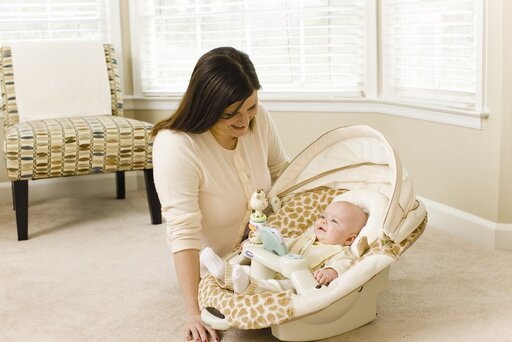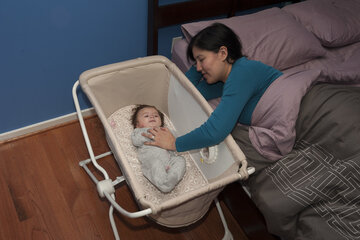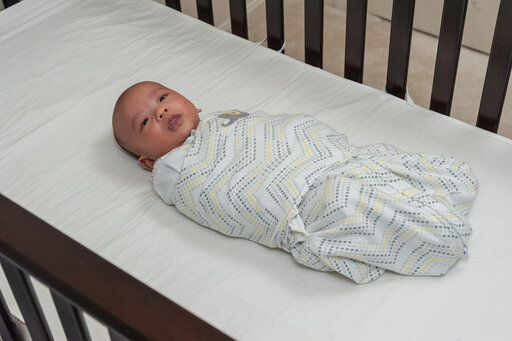
Welcoming a new baby into your family is an exciting and life-changing experience. As parents, you want to ensure that your little one is safe, comfortable, and happy.
One popular piece of baby gear that many parents consider is a baby swing, such as those offered by Graco. But the question arises: when can you put baby in graco swing?
In this article, we will delve into the appropriate age and developmental milestones for using a Graco swing, safety guidelines, and tips for maximizing its benefits.
By the end, you’ll feel confident in making an informed decision about when and how to use this helpful piece of equipment.
Understanding Graco Baby Swings
Graco is a trusted brand in the baby gear industry, known for its high-quality products. Their baby swings are designed to soothe and entertain infants, offering features like gentle rocking motions, vibration settings, and built-in melodies.
These swings can be a lifesaver for busy parents, providing a safe and calming environment for the baby while allowing you to attend to other tasks.
Additionally, many Graco swings come with advanced features like adjustable speeds, timer settings, and removable mobiles to engage your baby further.
Some models even include Bluetooth connectivity, enabling you to play your own music or control the swing through a smartphone app. With so many options, it’s essential to choose a swing that best fits your family’s needs.
However, as convenient as a baby swing may be, it’s essential to use it correctly and at the right time in your baby’s development.
When to Stop Using Baby Swings
Baby swings can be a lifesaver for parents, offering a soothing and secure space for little ones to rest or play. However, there comes a time when it’s essential to transition away from using them.
Knowing when to stop using a baby swing ensures your child’s safety and supports their developmental needs.
Here are some key indicators that it might be time to say goodbye to the baby swing:
Exceeding the Weight or Age Limit
Every baby swing comes with a manufacturer-recommended weight and age limit. Exceeding these limits can compromise the swing’s safety and stability.
Check the product manual to determine these thresholds, and stop using the swing when your baby outgrows them.
Increased Mobility
Once your baby starts rolling over, pushing up, or attempting to sit independently, the swing may no longer be safe. These newfound movements increase the risk of tipping or falling, even when strapped in securely.
Lack of Interest
Babies often outgrow their fascination with swings as they become more curious about exploring their environment. If your baby seems uninterested or restless in the swing, it may be a natural sign to move on.
Developmental Milestones
Prolonged swings may limit opportunities for essential physical activities, such as tummy time, crawling, or sitting. Encouraging floor play and interaction is crucial for your baby’s growth and motor skill development.
Safety Concerns
If the swing shows signs of wear and tear, such as fraying straps or malfunctioning components, it’s better to discontinue its use, even if your baby still fits within the recommended limits.
Transitioning away from a baby swing can feel like the end of an era, but it’s a step toward helping your baby grow and thrive.
Consider alternative soothing options, like a playmat, bouncer, or simply spending more cuddle time together. Always prioritize safety and follow your baby’s cues as you navigate this transition.
The Right Age for Using a Graco Swing

There is no one-size-fits-all answer to the question of when you can start using a Graco swing. Instead, it depends on your baby’s age, weight, and developmental readiness. Here are some general guidelines:
1. Newborns (0-3 Months)
Graco swings are often safe for newborns, provided they meet the minimum weight requirement specified in the product manual. Most Graco swings are designed for infants weighing at least 5 pounds. For newborns:
- Recline Position: Ensure the swing offers a fully reclining position to support your baby’s neck and head.
- Straps and Harness: Always use the built-in safety harness to keep your baby secure.
- Limited Duration: Limit swing time to short intervals, as newborns need plenty of supervised tummy time and opportunities to stretch and move freely.
2. Infants (4-6 Months)
By the time your baby is 4-6 months old, they’ll likely have better head and neck control. At this stage:
- Slightly Upright Position: You can use the swing in a slightly more upright position, depending on your baby’s comfort and readiness.
- Weight Limits: Check the swing’s weight limit, as some Graco models support up to 30 pounds while others have lower limits.
3. Older Babies (6+ Months)
Many babies outgrow the swing by 6-8 months due to increased mobility or reaching the swing’s weight limit.
If your baby shows signs of trying to sit up or roll over while in the swing, it’s time to transition to other forms of entertainment or soothing methods.
graco infant swing weight limit
Graco offers a variety of infant swings, each with specific weight limits to ensure your baby’s safety. Here are some popular models and their corresponding weight capacities:
Graco Simple Sway™ Swing
Designed for infants weighing between 5.5 to 30 pounds (2.5 to 13.6 kg).
Graco Slim Spaces™ Compact Baby Swing
Suitable for babies from 5.5 to 25 pounds (2.5 to 11.3 kg).
Graco Simple Sway™ 2-in-1 Swing
Accommodates infants weighing between 5.5 to 25 pounds (2.5 to 11.3 kg).
Graco DuetSoothe® Swing and Rocker
Designed for babies up to 30 pounds (13.6 kg).
It’s essential to consult the user manual of your specific Graco swing model to confirm its weight limit and adhere to all safety guidelines.
Discontinuing use once your child surpasses the recommended weight or exhibits increased mobility, such as attempting to climb out, is crucial for their safety.
Can You Put a Newborn in a Swing?

Yes, you can put a newborn in a baby swing, but it’s important to follow safety guidelines and use it appropriately. Here’s what you need to know:
- Age and Weight Recommendations
Most baby swings are designed for newborns and include a weight range starting from birth. Check the manufacturer’s instructions to ensure the swing is suitable for your baby.
- Recline Position is Key
Newborns have limited neck strength, so it’s crucial to use a swing with a fully reclined seat to support their head and neck. Avoid upright positions until your baby has better head control, typically around 4 months old.
- Supervise at All Times
Never leave your newborn unattended in a swing. Always keep an eye on your baby to ensure they’re safe and comfortable.
- Time Limits
Limit swing sessions to 30 minutes at a time to avoid overuse. Extended time in a swing can lead to flat spots on the back of a baby’s head or hinder natural movement development.
- Safe Sleep Warning
Baby swings are not intended for sleeping. If your baby falls asleep in the swing, transfer them to a flat, firm sleep surface, such as a crib or bassinet, as recommended by the American Academy of Pediatrics (AAP).
- Choose a Swing with Safety Features
- A 5-point or 3-point harness to secure your baby.
- Sturdy construction to prevent tipping.
- A swing speed that’s gentle and soothing, not too fast.
Final Thoughts
- Baby swings can be a lifesaver for soothing your newborn and giving you a break but always use them safely and sparingly. Prioritize your baby’s comfort and safety, and remember that swings are tools for soothing—not a substitute for safe sleep or tummy time.
When Do Babies Outgrow Swings?
Baby swings are a wonderful tool for comforting infants, but they’re not meant to be used indefinitely. Babies typically outgrow swings between 6 to 9 months, depending on their size, weight, and developmental milestones.
Here are some key factors to determine when your baby has outgrown their swing:
Weight Limit
Most baby swings have a weight limit between 20 to 30 pounds (9 to 13.5 kg), usually specified by the manufacturer. Once your baby exceeds this limit, the swing may no longer be safe or stable.
Age Range
Swings are designed for newborns and younger infants. By around 6 to 9 months, many babies begin to lose interest as they become more active and mobile, preferring to explore their environment.
Increased Mobility
When babies start sitting up, rolling over, or attempting to pull themselves out of the swing, it’s a sign that they’ve outgrown it. These movements can make the swing unsafe, even if the straps are secure.
Developmental Needs
As your baby grows, they need more time on the floor to strengthen their muscles, practice motor skills, and explore their surroundings. Overreliance on a swing may limit these opportunities.
Transitioning From the Swing
When your baby is ready to move on from their swing, you can explore other options, like:
1. A playmat or activity gym for floor play.
2. A bouncer or stationary jumper for seated engagement.
3. Plenty of supervised tummy time to encourage crawling and muscle development.
Pay attention to your baby’s growth and behavior, and always follow the manufacturer’s guidelines to ensure safe use of the swing. Transitioning to other activities will support your baby’s development and keep them safe as they grow.
Key Safety Guidelines for Using a when can you put baby in graco swing

Safety should always be your top priority when using a baby swing. Here are some crucial safety tips:
1. Follow the Manufacturer’s Guidelines
Every Graco swing comes with a user manual detailing weight limits, age recommendations, and setup instructions. Familiarize yourself with these guidelines to ensure proper usage.
2. Supervise at All Times
Never leave your baby unattended while they’re in the swing. While the swing can be soothing, constant supervision is necessary to prevent accidents.
3. Use the Safety Harness
Always secure your baby with the provided harness. This prevents them from sliding or falling out of the swing.
4. Place the Swing on a Flat Surface
Position the swing on a stable, flat surface away from stairs, edges, or other hazards. Avoid placing it on elevated surfaces like tables.
5. Limit Swing Time
Avoid keeping your baby in the swing for extended periods. The American Academy of Pediatrics (AAP) recommends limiting time in any baby gear
that restricts movement to reduce the risk of flat head syndrome and promote healthy development.
6. Monitor Your Baby’s Weight and Growth
As your baby grows, they may exceed the weight limit for the swing. Regularly check their weight and transition them out of the swing when needed.
7. Inspect for Wear and Tear
Regularly inspect the swing for any signs of damage, such as frayed straps or loose screws. Discontinue use if the swing appears unsafe.
Benefits of Using a Graco Swing
When used correctly, a Graco swing can offer several advantages for both babies and parents:
1. Soothing and Calming
The gentle rocking motion of a baby swing mimics the sensation of being in the womb, helping to calm fussy babies and lull them to sleep.
2. Hands-Free Time for Parents
A swing provides a safe space for your baby, giving you the freedom to tackle chores, eat a meal, or simply take a breather.
3. Entertainment and Stimulation
Many Graco swings come with built-in toys, sounds, and vibration settings to entertain your baby and support sensory development.
4. Routine Support
Using a swing can help establish a soothing routine for your baby, signaling nap time or providing comfort during cranky moments.
When to Stop Using a Graco Swing
Knowing when to transition your baby out of the swing is just as important as knowing when to start. Here are some signs it’s time to stop:
1. Reaching the Weight Limit
Most Graco swings have a weight limit between 25-30 pounds. Once your baby exceeds this limit, the swing may no longer be safe.
2. Increased Mobility
If your baby starts trying to sit up, roll over, or climb out of the swing, it’s time to stop using it. These movements increase the risk of tipping or falling.
3. Lack of Interest
As babies grow, they may lose interest in the swing and prefer more interactive forms of play.
4. Developmental Changes
As your baby becomes more active, they will benefit from activities that encourage crawling, standing, and walking. Transitioning to these developmental milestones means saying goodbye to the swing.
Alternatives to a Baby Swing
Once your baby outgrows their swing, you can explore other options to keep them entertained and soothed:
1. Bouncers and Rockers
These are great for slightly older infants and offer similar soothing motions in a more compact design.
2. Play Mats
Play mats with hanging toys encourage tummy time and help your baby develop motor skills.
3. Baby Carriers
For hands-free soothing, consider a baby carrier that keeps your baby close while allowing you to move around.
4. Stationary Activity Centers
Activity centers or exersaucers can provide an engaging space for older infants to explore and strengthen their muscles.
FAQs
1. when can you put baby in graco swing?
The AAP advises against letting babies sleep in swings, as it increases the risk of positional asphyxiation. If your baby falls asleep in the swing, transfer them to a flat, firm sleep surface like a crib or bassinet.
2. What if my baby doesn’t like the swing?
Some babies may take time to adjust to the swing. Try different settings, such as varying the speed or adding a favorite toy. However, if your baby continues to dislike the swing, respect their preferences.
3. How do I clean a Graco swing?
Most Graco swings come with removable, machine-washable seat covers. Follow the manufacturer’s instructions for cleaning the fabric and wiping down the frame.
4. How long can my baby stay in the swing each day?
Limit swing sessions to 30-minute intervals, with a total of no more than 1-2 hours per day. This ensures your baby has enough time for free movement and interactive play.
Conclusion
A Graco swing can be a valuable addition to your baby gear collection, offering comfort and convenience for both you and your little one.
By understanding when and how to use it safely, you can make the most of this helpful device. Always prioritize your baby’s safety and developmental needs, and don’t hesitate to consult your pediatrician if you have any concerns.
With proper use, a Graco swing can provide countless moments of peace and joy during your baby’s early months.
Whether you’re soothing a fussy newborn or giving your baby a relaxing place to rest, a Graco swing is a versatile tool that can support you through the challenges of parenting.
Embrace its benefits while keeping safety at the forefront, and cherish these precious early moments with your little one.


Leave a Comment